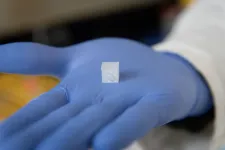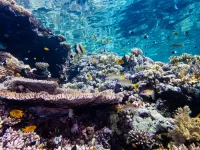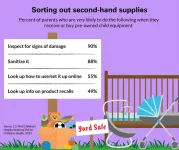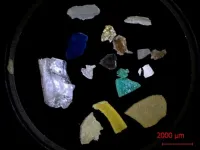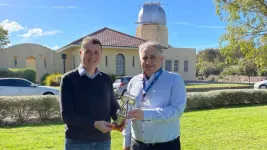(Press-News.org) WINSTON-SALEM, NC – MAY 15, 2023 – The Wake Forest Institute for Regenerative Medicine (WFIRM) will make history this month when the first bioprinted solid tissue constructs soar to the International Space Station (ISS) on board the next all private astronaut mission by commercial space leader Axiom Space.
The Axiom Mission 2 (Ax-2) launch by Houston-based Axiom Space is launching from Florida’s Kennedy Space Center. The crew will conduct extensive scientific research experiments including WFIRM’s vascularized tissue research – which won first place in the NASA Vascular Tissue Challenge in 2021.
Liver and kidney tissue constructs bioprinted by WFIRM scientists will be on the May Ax-2 launch from Kennedy Space Center in Florida to the ISS in low-Earth orbit. The tissues will be studied for 10 days to evaluate the vascularization of thick tissue in microgravity and the effectiveness of this platform technology for other tissue types.
“This launch marks an important next step for our regenerative medicine research related to vascularized tissue,” said WFIRM Director Anthony Atala, MD. “This is an opportunity to develop an interim/early step toward creating solid tissues/partial organs for transplantation into patients in the future to address the organ shortage.”
Previous research on ISS using cells in low-Earth orbit has included both 2D and small 3D cultures. These prior experiments have shown that cells exposed to micro-gravity undergo both genetic and functional changes, including increased motility and proliferation. Studying these larger tissue constructs in microgravity will help inform the researchers not only with regards to how the liver/kidney cells respond, but also as to how an endothelial coating of blood vessel cells will react to the altered atmosphere.
One of the most important factors in developing larger organ models is cell adhesion. This allows the cells to stick to each other or the material they are embedded in, creating multi-dimensional structures such as organoids and full tissues. This model will allow WFIRM researchers to delve into the specifics of cell adhesion in determining the overall 3D structure necessary to organ survival.
“While many components of cell adhesion have been studied in microgravity, every time the model changes it allows for new insight as to how changes in cell adhesion may affect human organs in microgravity,” said James Yoo, MD, PhD, professor of regenerative medicine at WFIRM. “We look forward to determining how this bioprinted tissue will model a more complete version of adherence reactions to microgravity.”
The WFIRM team will employ a digital light processing bioprinter that uses a light-curing resin made up of tissue cells to print the liver and kidney constructs into a unique-shaped architecture called a gyroid. The interconnected channels of the gyroid shape allow for a uniform flow of nutrition media throughout the inner surfaces of these cell-laden tissue constructs.
To prepare for launch, liver and kidney tissue constructs will be bioprinted independently. To assist in the maturation of the tissues, samples will be placed on flow, continuously exposed to perfused media for either five or ten days prior to launch. They will then be placed in transparent cell-culture containers that provide a closed system in which to grow the cells while on orbit.
While the research is taking place on the ISS, WFIRM research associates will be monitoring a duplicate set of samples on Earth. These will act as a gravity control and will undergo the same processes as those on the ISS. The team will be in communication during mission operations conducted on the ISS so the same activity timeline can be applied to the control constructs in the WFIRM lab.
While the primary focus for the team is on creating tissue constructs that can be used as a bridge to transplantation, they can also be used as a model system for human disease and testing potential new therapies as well as for studying health effects and developing potential countermeasures for astronauts who spend a significant amount of time in space.
“Taking the first steps toward future in-space manufacturing applications for biomedical products on Ax-2 is exciting,” said Jana Stoudemire, Director, In Space Manufacturing, Axiom Space. “We are pleased to work with recognized leaders from the WFIRM team, highly regarded for their excellence in tissue engineering and translational regenerative medicine, to advance this important work as we build a future commercial space economy together.”
WFIRM team members include WFIRM Director Anthony Atala, MD; James Yoo, MD, PhD; Sang Jin Lee, PhD; Colin Bishop, PhD; Kelsey Willson and Timothy Dombroski, PhD graduate students.
About the Wake Forest Institute for Regenerative Medicine: The Wake Forest Institute for Regenerative Medicine is recognized as an international leader in translating scientific discovery into clinical therapies, with many world firsts, including the development and implantation of the first engineered organ in a patient. Over 400 people at the institute, the largest in the world, work on more than 40 different tissues and organs. A number of the basic principles of tissue engineering and regenerative medicine were first developed at the institute. WFIRM researchers have successfully engineered replacement tissues and organs in all four categories – flat structures, tubular tissues, hollow organs and solid organs – and 16 different applications of cell/tissue therapy technologies, such as skin, urethras, cartilage, bladders, muscle, kidney, and vaginal organs, have been successfully used in human patients. The institute, which is part of Wake Forest School of Medicine, is located in the Innovation Quarter in downtown Winston-Salem, NC, and is driven by the urgent needs of patients. The institute is making a global difference in regenerative medicine through collaborations with over 400 entities and institutions worldwide, through its government, academic and industry partnerships, its start-up entities, and through major initiatives in breakthrough technologies, such as tissue engineering, cell therapies, diagnostics, drug discovery, biomanufacturing, nanotechnology, gene editing and 3D printing.
About Axiom Space: Axiom Space, the premier provider o human spaceflight services and developer of human-rated space infrastructure, is guided by the vision of a thriving home in space that benefits every human, everywhere. Axiom is opening new markets in low-Earth orbit through operating end-to-end missions to the International Space Station while privately developing its successor – a permanent commercial destination in Earth’s orbit that will sustain human growth off the planet and bring untold benefits back home. More information about Axiom and its generational mission can be found at www.axiomspace.com
END
WFIRM bioprinting research makes history when it soars to the ISS
Second private astronaut mission by Axiom Space targeting May launch
2023-05-15
ELSE PRESS RELEASES FROM THIS DATE:
Smartphone use goes up in city parks, but down in forests
2023-05-15
While a visit to the great outdoors is a common prescription for reducing screen use, a pioneering new study finds that time outdoors doesn’t always reduce smartphone screentime.
The new research, which tracked smartphone activity of 700 study participants for two years, reveals that participants’ smartphone activity actually increased during visits to city parks and other urban green spaces.
With smartphone use rising worldwide, the study clearly identifies a powerful way to reduce screen time: participants who visited nature reserves or forests saw significant declines in screentime over the first three hours, ...
New study finds the placenta, not only the brain, plays a central role in genetic risk of schizophrenia
2023-05-15
BALTIMORE, Md. (May 15, 2023) – More than 100 genes linked to the risk of schizophrenia seem to cause illness because of their role in the placenta rather than in the developing brain, according to a new study led by the Lieber Institute for Brain Development.
Scientists had generally assumed for over a century that genes for schizophrenia risk were principally, if not exclusively, about the brain. But the latest research, just published in Nature Communications, found that the placenta plays a much more significant role in developing illness than previously known.
“The secret of the genetics of schizophrenia has been hiding in plain ...
Wide-ranging strategies needed to eliminate racial and ethnic inequities in stroke care
2023-05-15
Statement Highlights:
In a review of the latest research, few stroke studies addressed racist policies, such as residential segregation, or social determinants of health, such as neighborhood deprivation, walkability or security; food availability; economic stability; education quality; or employment and health insurance, all of which play a role in stroke incidence, care and outcomes.
The statement summarizes research on interventions to address racial and ethnic disparities in stroke care and outcomes.
Additional research is needed to determine ...
Coastal lights trick coral reefs into spawning earlier than they should
2023-05-15
The light pollution caused by coastal cities can trick coral reefs into spawning outside of the optimum times when they would normally reproduce, a new study has found.
Coral broadcast spawning events – in which lunar cycles trigger the release of eggs on certain nights of the year – are critical to the maintenance and recovery of reefs following mass bleaching and other similar events.
However, using a combination of light pollution data and spawning observations, researchers were able to show for the first time that ...
New algorithm can predict diabetic kidney disease
2023-05-15
LA JOLLA, CALIF. – May 15, 2023 – Researchers from Sanford Burnham Prebys and the Chinese University of Hong Kong have developed a computational approach to predict whether a person with type 2 diabetes will develop kidney disease, a frequent and dangerous complication of diabetes. Their results, published in Nature Communications, could help doctors prevent or better manage kidney disease in people with type 2 diabetes.
“This study provides a glimpse into the powerful future of predictive diagnostics,” says co-senior author Kevin Yip, Ph.D., a professor and director of Bioinformatics ...
National Poll: 2 in 3 parents not confident they can tell whether used children’s equipment is safe
2023-05-15
Cribs, strollers and other infant and child equipment can be expensive and most families in a new national poll agree that it’s wasteful to buy these items new when they’re needed for such a short time.
But while half of parents say they have used pre-owned equipment for babies and young children, two in three acknowledge that it’s difficult to always know whether it’s safe for their child, according to the University of Michigan Health C.S. Mott Children’s Hospital National Poll on Children’s Health.
“Used child essentials ...
Managing cardiovascular disease risk factors may help preserve physical function as we age
2023-05-15
Managing cardiovascular disease (CVD) risk factors may play a role in preserving physical function during the aging process, according to new research published today by The Journals of Gerontology, Series A: Biological Sciences and Medical Sciences.
“Approximately 10% of older adults have muscle weakness and diminished physical function that leads to adverse health outcomes and physical disability,” said lead author Dr. Shivani Sahni. “Since loss of physical function contributes to reduced mobility, disability, institutionalization, and mortality, management of CVD risk factors can help preserve physical function with age,” ...
The Endocrine community joins forces on European Hormone Day to raise awareness of vital role of hormones in preventing and treating rare and chronic diseases
2023-05-15
PRESS RELEASE
EMBARGOED TO 15 MAY 2023
Contact: Victoria Withy
Head of Marketing, Communications and Membership
E: victoria.withy@ese-hormones.org
M: +44 (0) 7761 800855
Today, 15 May 2023, the European Society of Endocrinology (ESE), the European Hormone and Metabolism Foundation (ESE Foundation) and other partners are marking the second European Hormone Day.
European Hormone Day brings together all those with an interest in endocrine health and disease to promote a better understanding of the role of hormones and encourage a collective call for change about ...
How old is that microplastic? A new way to estimate the age of microplastics in the upper ocean
2023-05-15
Fukuoka, Japan—Researchers from Kyushu University and Asahi Kasei Corporation have developed a new way to estimate the age of microplastics found in the upper oceans. The method involves a combination of analyzing plastic oxidation levels with environmental factors such as UV exposure and ambient temperature.
The team applied their new method to estimate the age of microplastics found in nearshore and offshore sites in the North Pacific Ocean. They found that the age of microplastics in nearshore regions ranged from 0 to 5 years old, whereas microplastics from offshore regions ranged from 1 to 3 years old. Their ...
New deal inked to space test meta-optical surfaces
2023-05-15
A new engineering study has been commissioned by the European Space Agency (under PECS, the Program for European Cooperating States), to prove the reliability of meta-optical elements for space use in a collaboration between the ESA, Bulgarian start-up company LaboraXpert and TMOS, the Australian Research Council Centre of Excellence for Transformative Meta-Optical Systems.
In the first study of its kind, it will determine whether meta-optical components can withstand the pressures of space launch and prolonged exposure to the space environment.
TMOS Centre Director Prof. Dragomir Neshev says, “The demand for Earth observation data is growing, yet the industry still faces the ...
LAST 30 PRESS RELEASES:
Heart-brain connection: international study reveals the role of the vagus nerve in keeping the heart young
Researchers identify Rb1 as a predictive biomarker for a new therapeutic strategy in some breast cancers
Survey reveals ethical gaps slowing AI adoption in pediatric surgery
Stimulant ADHD medications work differently than thought
AI overestimates how smart people are, according to HSE economists
HSE researchers create genome-wide map of quadruplexes
Scientists boost cell "powerhouses" to burn more calories
Automatic label checking: The missing step in making reliable medical AI
Low daily alcohol intake linked to 50% heightened mouth cancer risk in India
American Meteorological Society announces Rick Spinrad as 2026 President-Elect
Biomass-based carbon capture spotlighted in newly released global climate webinar recording
Illuminating invisible nano pollutants: advanced bioimaging tracks the full journey of emerging nanoscale contaminants in living systems
How does age affect recovery from spinal cord injury?
Novel AI tool offers prognosis for patients with head and neck cancer
Fathers’ microplastic exposure tied to their children’s metabolic problems
Research validates laboratory model for studying high-grade serous ovarian cancer
SIR 2026 delivers transformative breakthroughs in minimally invasive medicine to improve patient care
Stem Cell Reports most downloaded papers of 2025 highlight the breadth and impact of stem cell research
Oxford-led study estimates NHS spends around 3% of its primary and secondary care budget on the health impacts of heat and cold in England
A researcher’s long quest leads to a smart composite breakthrough
Urban wild bees act as “microbial sensors” of city health.
New study finds where you live affects recovery after a hip fracture
Forecasting the impact of fully automated vehicle adoption on US road traffic injuries
Alcohol-related hospitalizations from 2016 to 2022
Semaglutide and hospitalizations in patients with obesity and established cardiovascular disease
Researchers ‘listen in’ to embryo-mother interactions during implantation using a culture system replicating the womb lining
How changing your diet could help save the world
How to make AI truly scalable and reliable for real-time traffic assignment?
Beyond fragmented markets: A new framework for efficient and stable ride-pooling
Can shape priors make road perception more reliable for autonomous driving?
[Press-News.org] WFIRM bioprinting research makes history when it soars to the ISSSecond private astronaut mission by Axiom Space targeting May launch
